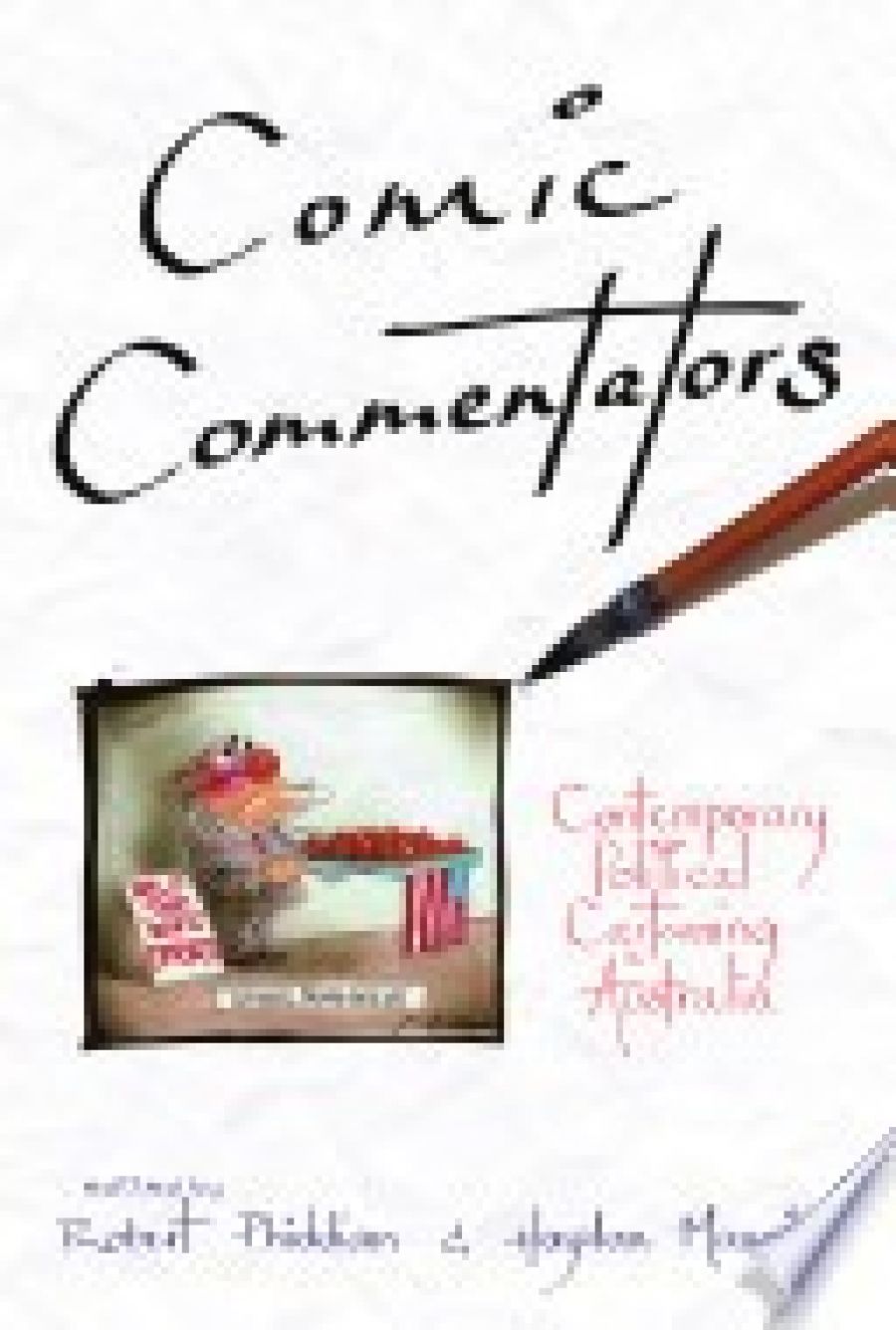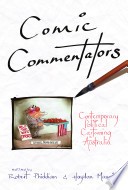
- Free Article: No
- Contents Category: Cartoons
- Review Article: Yes
- Article Title: The last redoubt
- Online Only: No
- Custom Highlight Text:
Like many people, I am addicted to a segment called ‘Talking Pictures’ on the ABC’s Insiders programme, hosted by Mike Bowyers. The three minutes are over in a flash. In fact, the brevity is well judged: humour needs understatement, not overkill. Watching those cartoonists for that short time, cheerful and amused as they invariably are in the face of folly, bastardry and disaster, the viewer is lifted above the baffling maelstrom, with a cleared head, steadied balance and restored vision. Of course, it can’t last. Comic Commentators, a collection of essays investigating political cartooning in Australia, is generously illustrated by a selection of nearly 120 cartoons that represent the output of Australia’s current crop of cartoonists. Two notable absences are Michael Leunig and John Spooner, both deferred to on several occasions, but not much discussed, and not illustrated. Fourteen contributions, arriving from many directions, converge: we hear from five practising cartoonists, an editor and an art curator, an academic lawyer with expertise in defamation and sedition, a social scientist and three academics in, respectively, the disciplines of government, politics and literature and culture. It is a productive mixture.
- Book 1 Title: Comic Commentators
- Book 1 Subtitle: Contemporary political cartooning in Australia
- Book 1 Biblio: Network Books, $35.95 pb, 261 pp
- Book 1 Cover Small (400 x 600):

Early on the editors, Robert Phiddian and Haydon Manning (both of Flinders University), make the point that cartooning ‘is one of the last redoubts for undisciplined, unspun commentary in a media increasingly managed by the … rise of public relations’. No doubt, but, as Marian Sawer’s piece about cartoonists and women’s rights shows, even cartoonists can be enlisted in the service of disciplined commentary when necessary. Sawyer, a committed feminist, writes of the ‘transgressive’ character of cartoons, but she doesn’t mean transgression against the values she holds. This marks the inevitable and non-negotiable collision between ideological discipline and unlicensed comedy.
The book is broken into four sections that lead naturally from one to the other. The first reports on the work of the practising cartoonist: Geoff Pryor on the cartoonist’s day, divided into ‘BI and PI’ (‘Before Idea’ and ‘Post Idea’); Ward O’Neill on the way changes in printing technology ‘shape artistic expression’; Fiona Katauskas, in a heartfelt piece, on the lonely insecurity of the freelancer.
The second, particularly interesting section examines constraints on cartoon freedom: editorial censorship under the threat of legal action; what can and what can’t be drawn. We get the editor’s view (Ian Matthews), then the cartoonist’s (Alan Moir). There follows an important and carefully researched article by Phiddian and Elizabeth Handsley, required reading for cartoonists and satirists especially: ‘The Political Cartoonist and the Law’. They conclude that cartoonists are generally safe from prosecution for libel because the defence of fair comment – an ‘honestly held opinion’ – is more certainly available to the cartoonist than to any other kind of public commentator.
A cartoon is obviously ‘opinion’ and ‘fair comment’, because the distancing effects of distortion and exaggeration preclude any possibility of a litigant arguing that what is offered is ‘fact’ – fact being the statement of literal truth that the libel action would need to prove. ‘What all this means is that the existence of an honest opinion defence provides cartoonists with a great deal of protection and, frankly, freedom to defame others ... [I]t is very difficult to see how cartoons will be mistaken for anything other than comment.’ It is the non-realist, transformative, pictorial and metaphorical nature of the cartoon image that accounts for the genre’s freedom, power and relative immunity from prosecution in any culture in which images are not proscribed. (This is the legal version of something that might be described more generally as ‘The Ruse of the Comic’, the problem that be devils any attempt to discuss any kind of humour, including comic art. If you take it too seriously, you look cack handed; if you say it is ‘only a joke’, or ‘only a cartoon’, you feel something important has got past you. Thus humour protects its own power and privilege.) As to cartoons and ‘sedition’ (Bill Leak is quoted as saying that ‘[s]edition is … a basic component of satire’), Phiddian and Handsley pay much attention to The Anti-Terrorism Act (no. 2) 2005. They conclude, surprisingly, that the act has had the effect of opening up, rather than closing down, opportunities for free expression. Still, as they note, the real threat to a cartoonist’s freedom is the fear of litigation rather than the actuality of prosecution. Not much comfort there, then.
The third section takes up the effectiveness of the cartoon from another angle. There is an absorbing, if unresolved, piece by Michael Hogan about whether cartoons have a measurable effect on public opinion. Hogan distrusts surveys, but he guesses that cartoons have contributed to a ‘moderate level of cynicism about politicians’. He is more cautious about whether cartoons actually change people’s minds in particular cases, citing, for example, the unanimous attacks by cartoonists in 2001 on the government’s immigration policy, as opposed to its then acceptance by ‘a majority of the population’. Still, Hogan thinks cartoons do change the way people think to a significant degree (the immigration issue, over time, is probably a case in point).
In the same section, Sawyer offers the finely detailed ac- count of women’s rights in Australia as seen and illustrated by cartoonists already mentioned, and two extended pieces by Manning: one on caricatures of women politicians, which, in an illuminating pairing, follows on from Sawer’s; and another on cartoonists’ views of Australian elections from 1983 to 2004. In his first piece, Manning is libertarian. He rejects any notion of restraint or self-censorship in line with even the worthiest cause, defends his cartoonists from the charge of sexism and reproduces a good selection of the cartoons against which the accusation can be made, just so you know: Leak’s Jenny Macklin as Playboy bunny, his Meg Lees as dominatrix with a grovelling, ‘into leather’ John Howard kissing her foot, his Cheryl Kernot cheerily in bed with Kim Beazley and Gareth Evans.
Given that politicians are the object of attack, Manning is right to take the stand he does: in such cases, power trumps gender or identity politics as the explanatory engine, and offensiveness is the point. His second piece – a survey of Australian elections – is less satisfying, perhaps because Manning doesn’t have room to discuss the cartoons as anything other than illustrative commentary (‘compactly and pleasantly conveying political history’, as he puts it). Thus, we are denied the opportunity of watching him unpack the complicated semiotics of what is clearly a favourite cartoon: Geoff Pryor’s marvellous ‘Medicare Gold/Ladder of Opportunity’ take on Latham’s 2004 campaign.
The last part, ‘Cartoon History’, gives us Guy Hansen on exhibiting cartoons, and Lindsay Foyle on the history of cartooning at the Australian, as well as two more analytical discussions of the careers of contrasting cartoonists, Bruce Petty and Patrick Cook. Phiddian’s piece is an outline of Petty’s career up to 1975, when he left the Australian in protest at Murdoch’s support for the dismissal of Whitlam and the new Fraser government. Phiddian’s Petty is a man of integrity, living an ‘exemplary life’ and, by extension, building an exemplary career. (It will be interesting to see how this holds up in the biography of Petty that Phiddian is currently writing.) Phiddian is illuminating on Petty’s art – noting that he is above all the drawer of ‘process’. In a brief contribution to the theory of cartoon work, he describes Petty’s cartoons as ‘metaphors’, an idea that at a stroke raises us above ethnographical worrying about the effect of cartoons, or seeing cartoons as the pictorial deposit of social and political history. For Phiddian, cartoons are expressive and meaning-making inventions, not merely event-recording or mood-reflecting receptacles.
Mark Thomas concludes the collection with a stimulating contrast between the work of Petty and Patrick Cook. It demonstrates the revelatory power of a simple binary contrast: Petty, the wounded, optimistic humanist, his Australia an ‘amazingly special place for ordinary people’ (though he notes that Petty’s drawings often mock the order and coherence the artist implicitly values); Cook, the brutal, indignant, smart-arsed, bad-taste ironist, angrily and experientially involved. Thomas demonstrates, too, the purchase of old-fashioned descriptive criticism, as in his account of Petty’s ‘no flow charts’: ‘a remarkable array of strings, wires, lines, tubes, pipes, chutes, pulleys, weights, conveyor belts, ropes and balances’ that crush the little people ‘like insects’, staging ‘a tragedy enacted both front and centre’. Somewhat against Thomas’s preference for Cook, somewhat against his even-handed conclusion, Petty emerges as the more considerable figure.
As well as showing productive disagreement among contributors – the divergence between Sawyer’s and Manning’s article is a case in point – the collection should prompt further discussion among its readers, such as, for instance, an investigation into a matter raised by Katauskas, the paucity of women political cartoonists in staff positions in Australian newspapers (a dearth that would probably be found across the world). Her claim is borne out by the selection of cartoons in the book: of 117 cartoons only sixteen are by women. What accounts for this? Katauskas’s explanation, that women are not good at self-promotion, is unconvincing. Many of the male cartoonists, including Petty, point to the predominantly negative and aggressive slant of the successful political cartoonist. Among the images reproduced in the book, it is the hostile, aggressive, attacking, unfair ones that stand out, such as those that make Leak such a powerful force. Are women cartoonists for whatever reason – one resists any essentialist explanation, but there might be a cultural one – chary of this kind of aggressiveness? Further, does political cartooning require some conventional notion of male aggression at its core, an anger that fuels metaphoric inventiveness, perhaps, which women cartoonists, for whatever reason, shy away from (the cartoons by women reproduced here are predominantly gentle)?
These are genuine questions, and I don’t know what the answer is. For what it is worth, in my own tentative foray into cartooning, now some years in the past, I often thought that just that absence of attack in my drawing was what made me hopeless as a political cartoonist – which might support the point about aggression, though not, in any meaningful sense, about gender. This is only one of many lines of discussion this welcome and rich collection should stimulate.


Comments powered by CComment